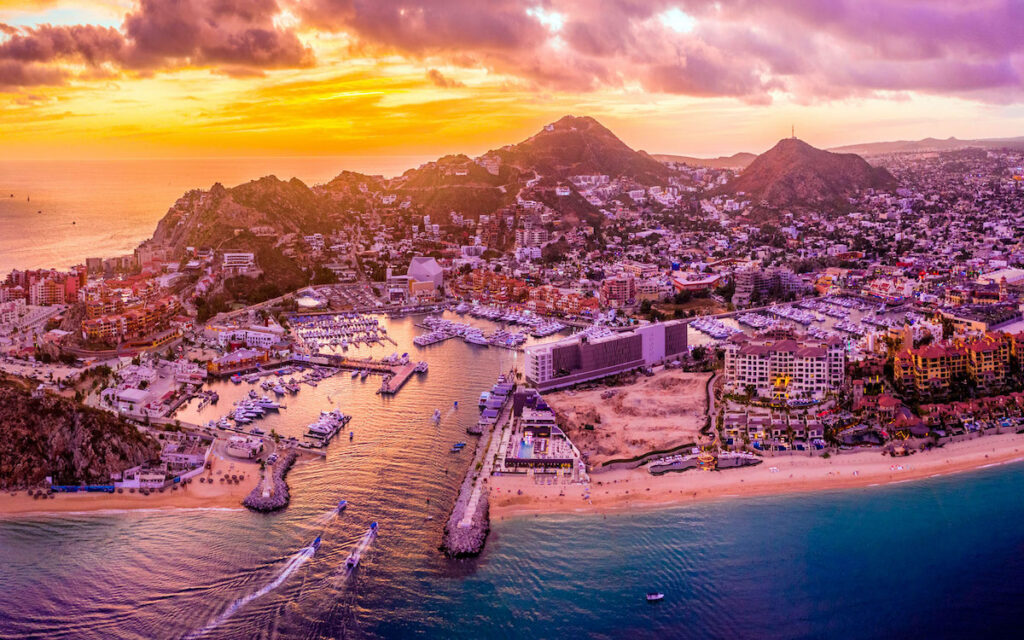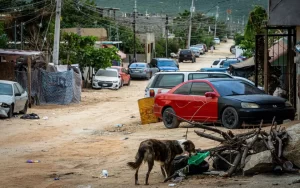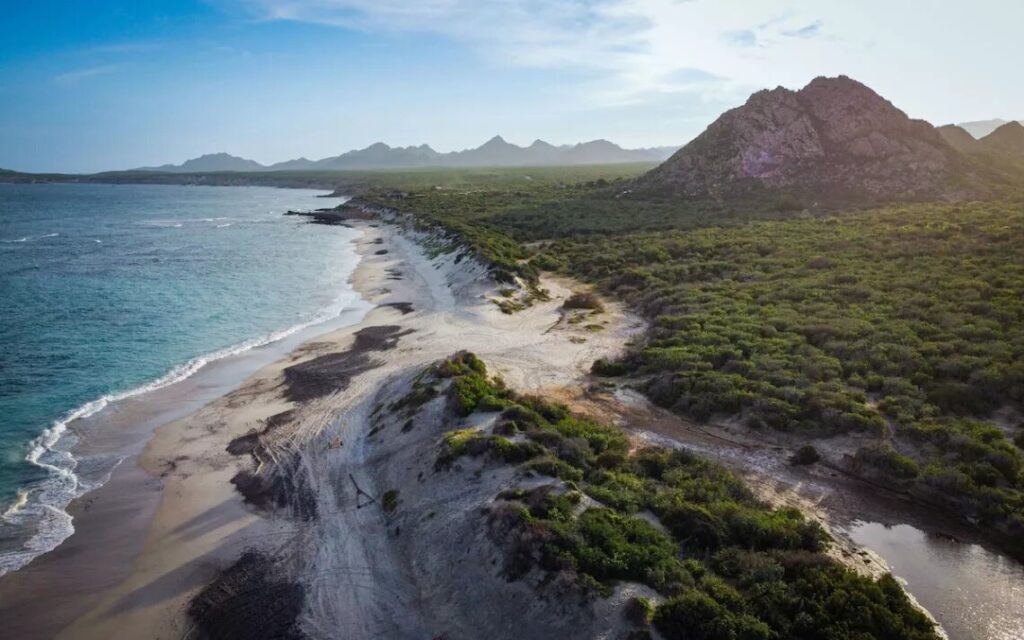From the boat, an impressive mass of bigeye jacks can be seen darkening the surface of the ocean. The guide counts to three and they all dive. Soon, thousands of silver fish surround them, moving in synchrony like a living wave. Although individually they are simple, together they create an impressive spectacle.
When you look up out of the water, you can see the glittering sea and the mountains of Baja California Sur in the distance. The guide points out a hawksbill turtle, and as they explore further, they find other turtles, an eagle ray, various fish and colorful reef creatures.
This remarkable biodiversity is due in part to the underwater geology and currents, but mainly to the commitment of the people of Cabo Pulmo. In the 1980s, local fishermen noticed a decline in marine life and took the decision to protect the reef, thus encouraging the ecotourism. Finally, in 1995, the area was declared as a national marine parkprohibiting fishing.
By 2009, fish biomass increased by 463% and predators such as sharks increased 10-fold. Cabo Pulmo thrived, growing from six homes in the 1970s to a community of 300 people with schools and local businesses, while maintaining its rustic charm and commitment to conservation.
However, the property development and megaresorts threaten to damage biodiversity and displace people, putting at risk what is already there. Cabo Pulmo has been able to protect.
While local activists fight against the worst projects, opposing visions for the future of East CapeWill tourism and gentrification consume the region, or will people find a way to balance growth with preserving the connections between the desert, the sea and human communities?
The development of Los Cabos and its impact
The Baja California peninsulaThe 1,200-kilometer-long, 1,200-kilometer-long, arid mountain range stretches into southern California, with arid mountains crashing against the Pacific Ocean to the west and the Sea of Cortez to the east. Intermittent streams transport freshwater and nutrients to the coast, feeding marine life and recharging essential aquifers.
The scarcity of fresh water in Baja California Surone of Mexico's driest and most sparsely populated states, has kept the region isolated. However, in the 1970s, the Mexican government decided to convert communities such as Los Cabos in tourist resorts to boost the economy. With road improvements and the construction of an airport, Los Cabos was transformed into a luxury tourist destination.

This development, however, came at a cost. Construction interfered with water flow, reducing aquifers and beaches, and the hotels walled off the coast, displacing local families who had lived there for generations. Now, East Cape faces a similar dilemma, seeking to strike a balance between the tourism development and the environmental conservation.
Meanwhile, tourism workers, many of them migrants from other parts of Mexico, live in precarious settlements on the outskirts of the city, often without running water in temperatures above 37°C. In 2006, 15% of households lacked potable water, while hotels used large amounts of water. The ecosystems also suffered: in 2022, Los Cabos had the lowest fish biomass recorded in Baja California Sur.
This sprawling development, once limited to Los Cabos, now extends northward. East Cape, known for its beauty and tranquility, has kept the crowds at bay thanks to its challenging roads. However, Los Cabos-style development is coming.
Developments begin to arrive in East Cape
Queen Macklisenvironmental activist from La Riberaa coastal community located less than 30 kilometers from Cabo Pulmofears that pollution will reach his city. A mega-development called Costa Palmas is under construction between its village and a nearby creek. This complex will include two luxury hotels, 400 private homes, polo fields, organic farms, 20 restaurants, a golf course and a marina.
Macklis shows how Costa Palmas is already impacting the local population and the ecosystems. A stone wall diverts water from the creek, preventing it from recharging the La Ribera aquifer. Since Costa Palmas opened, residents have suffered water shortages. In contrast, a single golf course uses enough water daily to supply 9,000 people.
Development in East Cape includes permits for nine additional golf courses, 12,500 hotel rooms and 10,000 new homes, with more in the pipeline. The population nearly doubled between 2010 and 2020, and is expected to exceed 138,000 people by 2040. This growth is driven by tourism and construction workers, as well as foreign owners buying property through trusts, putting additional pressure on the region's scarce water.
Walking from the creek to the beach, Macklis points out raccoon and bird tracks in the sand. Leatherback and olive ridley turtles and the endangered least tern nest here. "There are a lot of species," Macklis says, pausing next to a mangrove-lined wetland where a blue heron and migrating ducks rest. The area is also home to the Belding's warbler.
Suddenly, the wetlands end up in a large construction zone.
"All of that was mangroves," says the activist.
Satellite imagery shows that the wetlands around the creek were drastically reduced with the construction of Costa Palmasalso affecting the beach, which is accessible to the residents of La Ribera.
Costa Palmas has transformed the community. La Ribera, once a quiet town, now faces overcrowding in schools and clinics, and security has deteriorated. Macklis avoids going to the beach alone for fear of reprisals, as she has documented the destruction caused by the project.
Accelerated growth, on the lookout for Cabo Pulmo
On the way to Cabo PulmoAs the road is blocked by the Costa Palmas development and construction trucks, travelers may find roads blocked by the Costa Palmas development and construction trucks. However, as you head south, the landscape seems to calm down. The desert, surprisingly green due to a recent hurricane, is interspersed with cactus and flowering shrubs.
Despite the apparent tranquility, even in this remote corner there are signs of development. Every few kilometers, travelers can see "For Sale" signs. The sale of these lots could lead to the construction of second homes and hotels, which would threaten the protected ecosystem of Cabo Pulmo.
Armando Trasviña Castrooceanographer, says that Cabo Pulmo is a successful example of conservation, but that the accelerated growth around it affects it. Nutrients from La Ribera creek, 30 kilometers away, feed marine life on Cabo Pulmo's reef. Sarahí Gómez Villadamarine biologist, states that the entire environment is connected.
Angeles CastroThe granddaughter of one of the founders of the community, expresses concern about the "For Sale" signs and the impact of development. She worries that developments around Cabo Pulmo will drive her family away and make real estate more expensive, making the coastline inaccessible to many Mexicans.
"I thought we were untouchable," Angeles says. "But all these people with money have their eyes on us... They want to protect this place. They want to protect it from us."

The inequality is a by-product of the mass tourism that has remodeled places such as Los Cabos and Cancun. Ryan Andersonanthropologist at the Santa Clara Universityexplains that locals tend to be pushed out in tourist areas. This phenomenon follows Butler's Tourist Area Life Cycle: first a place is "discovered," then it develops, and locals lose control as outside workers take new jobs. The community changes, often to the detriment of the locals, creating an inequality so stark that it is called the "de facto social and economic apartheid.".

The mass tourism can cause a place to lose its authenticity. Although the number of tourists continues to grow in Los CabosMany become disillusioned and look for more authentic places. This drives development in other parts of the East Cape. Cabo Pulmo's biodiversity is a major attraction, and developers promote it as an asset. The Mexican government is even proposing to pave the coastal road between Los Cabos and Cabo Pulmo, making it easier for tourists, investors and expatriates to access the isolated beaches and nearby towns.
The Mexican Center for Environmental Law is compiling data to demonstrate the negative impact of a proposed new development on the border of the Cabo Pulmo National Park. January 2024, PROFEPA declare the project illegal, although construction continued for weeks until a local organization intervened.
These successes are encouraging, but regulatory enforcement remains weak. Many believe that the construction of Costa Palmas is illegal. However, money often influences more than the law, and developers often operate without proper permits or ignore the conditions of their permits.
Development projects continue to pop up, exhausting activists. One woman who used to fight against these projects says she has stopped.
At Cabo Pulmothe community celebrates the Day of the Dead with an ofrenda contest. One of them, in a hut, is dedicated to extinct species. The children listen to a woman explain the disappearance of each species, highlighting the importance of protecting biodiversity.
That night, the community gathers under the Milky Way. Despite the challenges, there is a sense of hope and determination to protect their environment and way of life.
Source: Sierra


